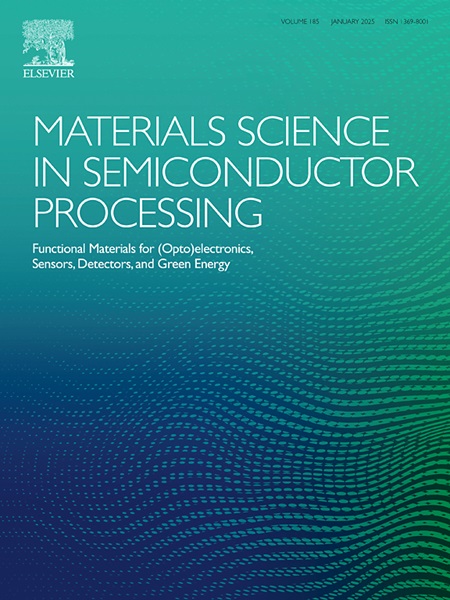Inhibition on the growth of interfacial IMCs in Sn-15Bi molten solder with Ni or Co substrate under temperature gradient
IF 4.6
3区 工程技术
Q2 ENGINEERING, ELECTRICAL & ELECTRONIC
引用次数: 0
Abstract
We reported to use different substrate pad to suppress the atomic migration and the growth of interfacial intermetallic compounds (IMCs) in Sn-15Bi molten solder joints under thermomigration, and investigated the thermomigration behaviors with copper as cold substrate but altering the hot substrate with copper, cobalt or nickel. A fin structure on Cu cold substrate was designed to magnify the thermomigration in solder matrix. Finite element simulation showed that Cu hot substrate exhibited the largest temperature gradient compared with Ni and Co. Under the combined effect from temperature gradient and chemical potential, more substrate atoms diffused through molten Sn-15Bi and enrolled into the interfacial reaction. Compared with the interfacial Cu6Sn5/Cu3Sn IMCs in Cu/Sn-15Bi/Cu joints, (Cu,Ni)6Sn5 was observed at the interface in joints with Ni hot substrate, and (Cu,Co)6Sn5/(Co,Cu)Sn3 were at the interface in joints with Co hot substrate. The thermomigration promoted the asymmetrical IMCs' growth in joints with the hot substrate of Cu or Ni, but compared with Cu hot substrate, Ni hot substrate can obviously retard the thermomigration induced interfacial IMCs' growth on the cold substrate. In Cu/Sn-15Bi/Co, the interfacial asymmetrical IMCs’ growth at the cold substrate was completely suppressed with fast growth of Cu-Co-Sn IMCs at the hot Co substrate because of the slow diffusivity of Co in Sn compared with Cu or Ni in Sn. Co substrate provides better thermomigration resistance than Cu or Ni.
温度梯度对Ni或Co钎料Sn-15Bi界面IMCs生长的抑制作用
本文报道了不同衬底衬垫对Sn-15Bi熔融焊点中原子迁移和界面金属间化合物生长的抑制作用,并研究了以铜为冷衬底而以铜、钴或镍改变热衬底时的热迁移行为。设计了一种在Cu冷衬底上的翅片结构,以放大焊料基体中的热迁移。有限元模拟结果表明,Cu热衬底比Ni和Co热衬底表现出最大的温度梯度,在温度梯度和化学势的共同作用下,更多的衬底原子通过Sn-15Bi熔体扩散并参与到界面反应中。与Cu/Sn-15Bi/Cu界面的Cu6Sn5/Cu3Sn IMCs相比,在Ni热基体界面处观察到(Cu,Ni)6Sn5,在Co热基体界面处观察到(Cu,Co)6Sn5/(Co,Cu)Sn3。热迁移促进了与Cu或Ni热衬底的界面IMCs的不对称生长,但与Cu热衬底相比,Ni热衬底可以明显延缓热迁移诱导的界面IMCs在冷衬底上的生长。在Cu/Sn- 15bi /Co中,Cu-Co-Sn界面不对称IMCs在冷基体上的生长完全被Cu-Co-Sn界面不对称IMCs在热Co基体上的快速生长所抑制,这是因为Co在Sn中的扩散速度比Cu或Ni在Sn中的扩散速度慢。Co衬底具有比Cu或Ni更好的耐热性。
本文章由计算机程序翻译,如有差异,请以英文原文为准。
求助全文
约1分钟内获得全文
求助全文
来源期刊

Materials Science in Semiconductor Processing
工程技术-材料科学:综合
CiteScore
8.00
自引率
4.90%
发文量
780
审稿时长
42 days
期刊介绍:
Materials Science in Semiconductor Processing provides a unique forum for the discussion of novel processing, applications and theoretical studies of functional materials and devices for (opto)electronics, sensors, detectors, biotechnology and green energy.
Each issue will aim to provide a snapshot of current insights, new achievements, breakthroughs and future trends in such diverse fields as microelectronics, energy conversion and storage, communications, biotechnology, (photo)catalysis, nano- and thin-film technology, hybrid and composite materials, chemical processing, vapor-phase deposition, device fabrication, and modelling, which are the backbone of advanced semiconductor processing and applications.
Coverage will include: advanced lithography for submicron devices; etching and related topics; ion implantation; damage evolution and related issues; plasma and thermal CVD; rapid thermal processing; advanced metallization and interconnect schemes; thin dielectric layers, oxidation; sol-gel processing; chemical bath and (electro)chemical deposition; compound semiconductor processing; new non-oxide materials and their applications; (macro)molecular and hybrid materials; molecular dynamics, ab-initio methods, Monte Carlo, etc.; new materials and processes for discrete and integrated circuits; magnetic materials and spintronics; heterostructures and quantum devices; engineering of the electrical and optical properties of semiconductors; crystal growth mechanisms; reliability, defect density, intrinsic impurities and defects.
 求助内容:
求助内容: 应助结果提醒方式:
应助结果提醒方式:


